Taft Avenue Community Church - Orange, CA
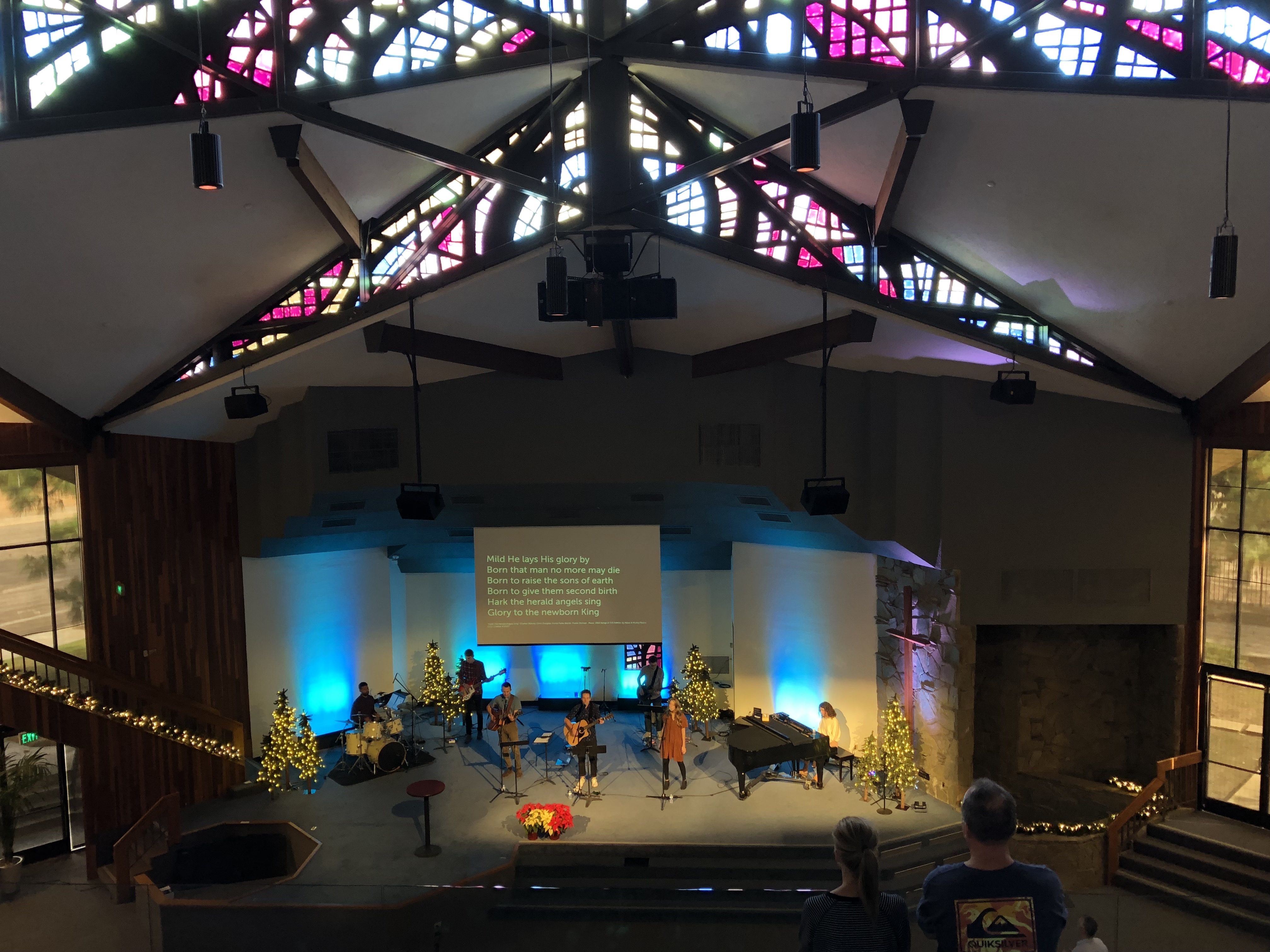
Taft Avenue Community Church in Orange, CA is like a lot of churches; they’ve been around for decades, and their current building is 50-ish years old. Most of their AV technology is pushing 20 years old and much of it was installed by well-meaning but under-informed volunteers.
Case in point; their speaker system was actually designed by a professional, but when it came time to install it, the church (back then) balked at the price and they decided to do it themselves. Instead of following the design, they spread the speakers out throughout the room. Unfortunately, they didn’t know about delay and thus the resultant coverage was less than optimal (I’m being generous…).
When their current pastor came on board just over a year ago, he recognized the church needed some updates. We were engaged and took them through our 4Site Design Workshop. During that workshop, it became clear that while pretty much all their technology needed to be replaced, the biggest pain points were house lighting and the audio system.
We did a master plan design, which provides the framework for upgrading all their technology as time allows. They gave us a budget number they could work with now, and we came up with a plan to replace their house lighting, DMX distribution, architectural and theatrical control, speakers, audio console, wireless mic and give them a new personal mixing system. At the last minute, an anonymous donor supplied funds to replace and move their theatrical lighting. Let’s go through it system by system.
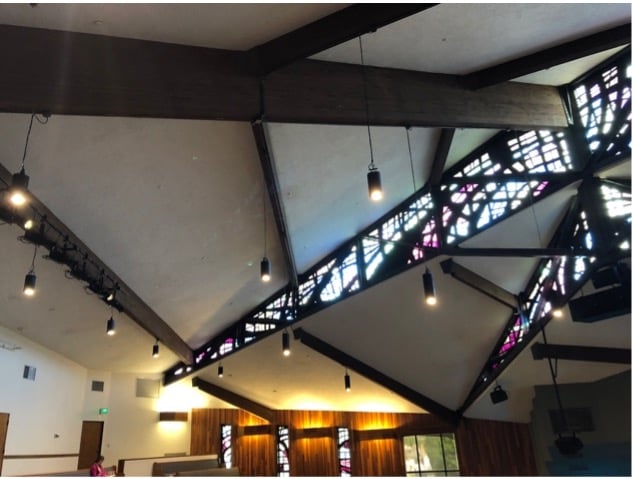
We originally designed the system with Aquarii Acceleron fixtures, which are very nice white-only units. However, when it came time to kick off the project, those fixtures were back ordered by several months. I re-worked the design with Chroma-Q Inspires and found I could make it work for roughly the same budget. As a bonus, they got color.
That was actually a fun story; we ended up surprising them with that feature. While the project was being installed, the pastor had said, “Man, I wish we could have gone with the color-changing house lights, but we just couldn’t afford it.” My installer, knowing what we were doing, smiled and said, “Yeah, that would have been cool, huh?” When I was training them on the use of the lighting console, it was really great to see everyone’s face light up when I said, “And if you want to make the house another color, do this…”
Because the ceiling was so high in the room—some 38’ to the peak—we used Inspire XTs for the main floor lighting. The original Inspire was used for the over-balcony areas and Inspire Minis with recessed kits were placed under balcony. This was the only area that didn’t work out quite as well as if we had gone Aquarii. The Acceleron fixtures are available with up to 110° lenses, which would have evened out the coverage under the balcony a bit. With 65° lenses, the Inspire Minis pool light a little more than I would have liked. Everyone is fine with it, but even another 15° would have helped us out. We could have added fixtures, but that would have exceeded the budget.
Coverage on the main floor and in the balcony is excellent, however. We actually gave them roughly double the number of foot-candles in the seating area they used to have. We used this as another fun reveal on opening weekend. The leadership team decided to set walk-in and worship levels at roughly what their old system would do. I watched more than one person walk in, look up and say to someone near them, “I thought it was supposed to be brighter?”
When we go to the scripture reading portion of the service, Pastor Craig stood up and said, “Let’s stand for the reading of the Scripture, and let’s turn the lights up so you can read your bibles.” When the lights went to full, there were gasps and cheers throughout the congregation. That was extremely gratifying.
I lost a lot of sleep on that house light design; what we installed was actually the fifth iteration of the design. Because the room has a crazy multilayer vaulted ceiling, angled walls, a wrap-around balcony with stairs on one side and nary a right angle in sight, finding a way to let the installers know where to locate the fixtures was a challenge. Thankfully, our guys are pros and we got on the phone and came up with a plan. I located all the fixtures on beams and was then able to provide them measurements from junctions with other beams. Setting heights was still a bit of a trick, but a laser level on a C-stand made it work. As a side benefit, because all the fixtures landed on beams, the conduit runs were extremely clean.
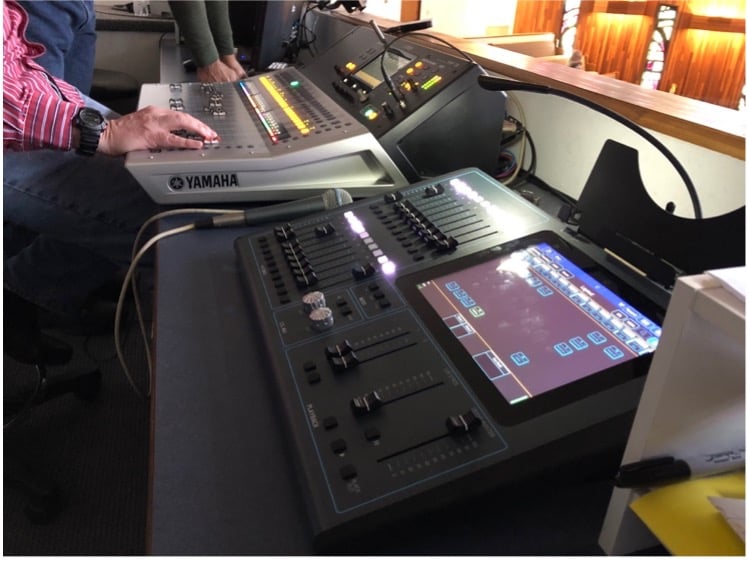
For theatrical lights, we used the venerable Chauvet E-160 WW light engines. We re-used their existing Source 4 lens tubes and suspended the fixtures from schedule 80 aluminum battens from The Light source. A Chamsys QuickQ10 provides theatrical control, which is a huge improvement over the three analog dimming controllers they used to have. A Pathway Octo 8 gave us sACN and DMX distribution, giving them the ability to expand to as many universes as they’ll ever need in the space.
For architectural control, I used my favorite controller, the Cue Server—in this case a Cue Server Mini. Interactive Technology keeps improving the software and interface of that system and it’s become incredibly powerful while remaining easy to program. We installed three 6-button wall stations to give them control. Through a little programming magic, I create multiple looks for each set of fixtures, and make them available through multiple button presses. For example, the house lights can be set at full, 75%, 50% 25% or off by pressing the top button multiple times. The second button provides four different stage lighting looks. In this way, we can make the room easy to use for people who don’t want to learn to use the lighting board.
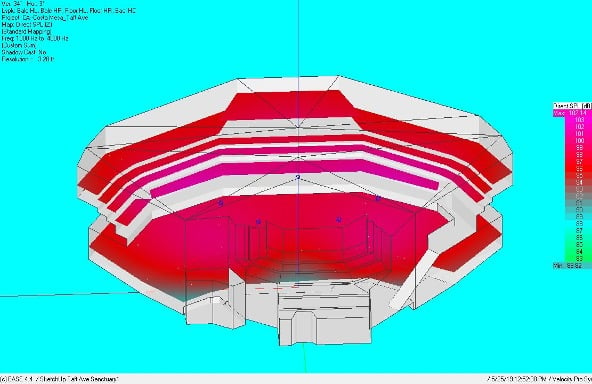
When I first saw pictures of the room, my first thought was Martin Audio CDD. Going through the design process, I tried multiple options from various manufacturers, and sure enough CDD proved to be the best choice. Not only is it budget-friendly, they sound amazing and gave us ±2 dB coverage over the whole listening area…almost. We do lose the very far out seats of the balcony in the top rows. It’s still very listenable, but it is down about 4 dB. Otherwise, the coverage is incredibly even.
One thing I really strive to achieve is the same response at FOH as in the seating areas. This is especially important in rooms like this where FOH is upstairs at the top of the balcony in a room that juts out into the space. As you can see from the trace below, we pretty much nailed it. No more does the engineer need to wander the space to see what’s going on in the rest of the room. What he hears is what the congregation hears.
We originally planned on the unpowered CDD line for this project, but when it came time to order, CDDs were several more weeks out. Martin did what Martin does and took care of us and got us CDD Live! instead. I love the CDD line, but I really love the CDD Live! line. The built-in amps and DSP make great sounding speakers even greater. When all was said and tuned, I had 4 filters in the system with a max change of 4 dB. They don’t take much to get them sounding awesome once the timing is all set.
Low end is provided by three SX118 subs flown in the center, powered by a Via 5002 amp. I’m a big fan of center flown subs because the coverage is so even. Yes, you lose a little kicked in the chest by a mule feeling, but this church isn’t about that anyway. What we gain instead is incredibly even low end. And for fun, I did turn it up on the Cirkut Remix of Blow and it did indeed rock.
To replace their aging Allen & Heath 3300, we went with a Yamaha TF-3. While I’d personally prefer an A&H SQ for mixing, the TF line has very useful features for less skilled volunteer mixers. They made one-knob control work like no one else has, and the library of starting points for various mics and compression profiles is actually very good. I like the fact—for them anyway—that patching is always 1:1. While I like to be able to double-patch channels, it’s confusing for people coming to digital for the first time, and I’ve spend more than few phone calls trying to troubleshoot stuff like that. We gave them two TIO-1608 stage racks which will keep them in inputs for a long time.
For wireless mics, we turned to Shure’s QLX-D line. These are my go-to mics when budgets are a little tight for ULX-D. Paired with an RF Venue Distro4 and DFin antenna, dropouts become a thing of the past.
Digital Audio Labs LiveMix rounds out the system for personal mixing. We went with the Dante input module, which makes it easy to do some limited amounts of foldbacks from FOH without making it too complicated.
Finally, I put in a Symetrix Prism 4x4 for distribution to the subs and assisted listening system (from Listen Technologies), and for EZ control. We mounted an ARC-3 on the wall at FOH, and if they need to run a simple event with a few wireless mics, they can engage EZ mode which bypasses the console and takes the wireless mics into an auto-mixer with the proper levels pre-set. Between this control and the lighting button stations, nearly anyone can use the room with lighting and basic audio with just a few button presses.
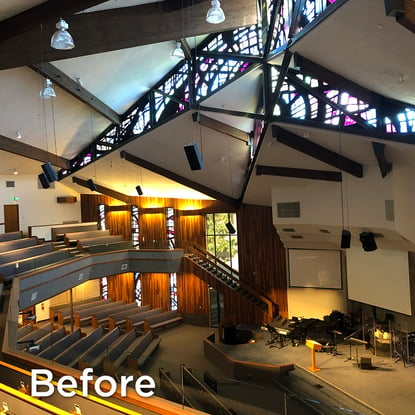
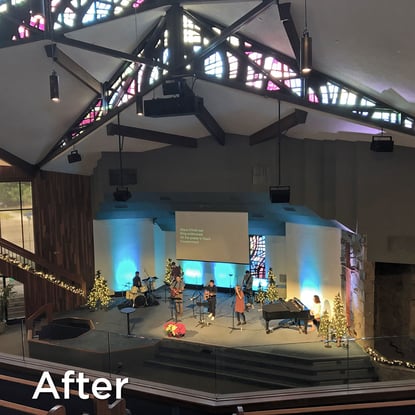
Results
At the end of the day, it’s not about how cool we think the system is, but how the church likes it. And they are thrilled. Everyone was blown away with the house lighting, and music and teaching has never sounded better. No more do people have to sit in a “magic” seat to actually hear the message. Any seat will do. The system is designed to give them plenty of room for growth in the future as the church grows.
There’s a really good reason I’ve used all these pieces of gear on many, many projects over the years—it just plain works. And, it’s predictable. EASE showed that we would be down 4 dB on the far outside seats of the balcony, and we are. It also showed we were in great shape everywhere else. The lighting is just as even as predicted, if not more so. All this highlights why it is imperative to do proper design on a system before spending money on equipment.
So, that’s it. Another successful project is in the books. I can’t thank our manufacturing partners enough for making great gear that does what it’s supposed to do every time. My installers Jake & Bob went way above and beyond on what turned out to be a much more challenging installation process than we all thought. Great gear installed by great people really makes my job a lot easier.
For more information on how we can help your church, contact us at hello@vantageproav.com
Check out our YouTube page https://www.youtube.com/@vantageproav
Audio
Theatrical Lighting
House Lighting


